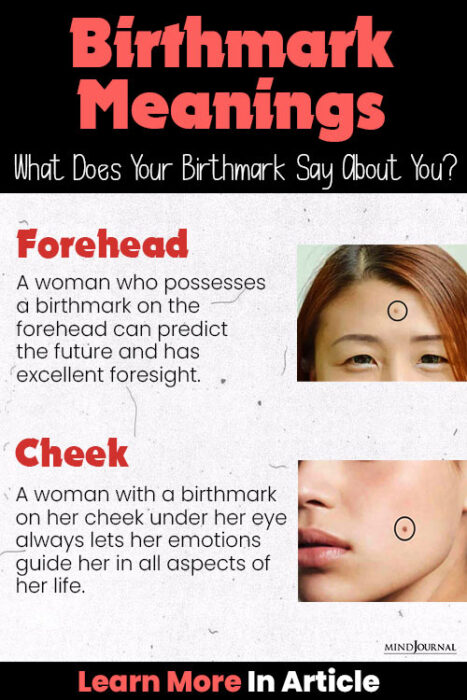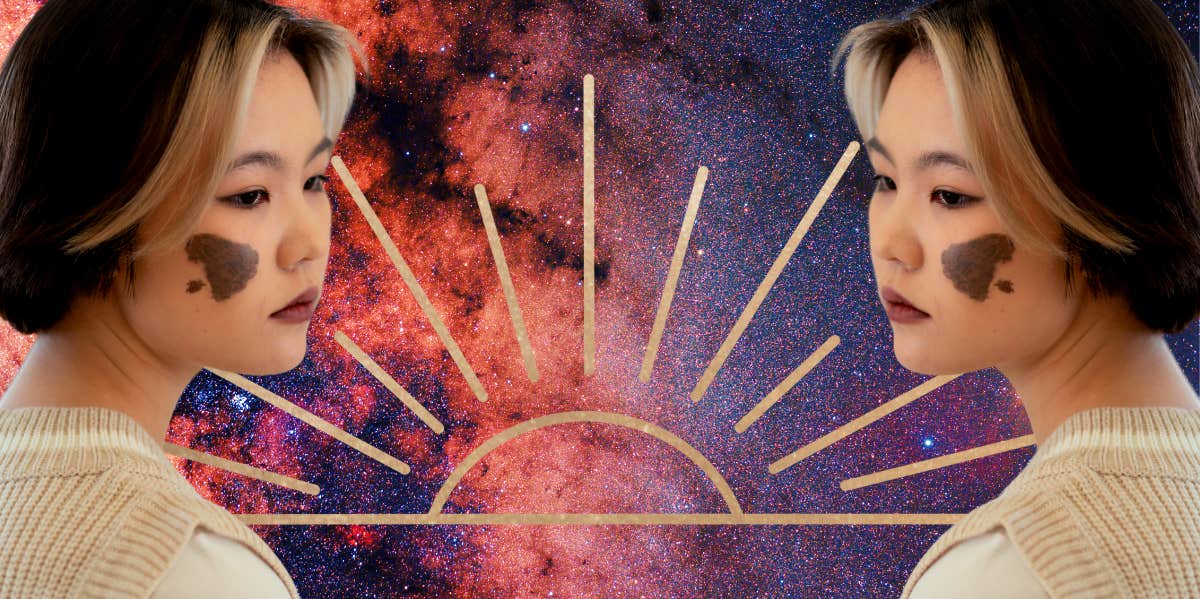A birthmark on the face can have various meanings, depending on its location, size, shape, and coloration. It can be a result of an excess or lack of pigmentation in the skin, or it may be caused by abnormal blood vessels.
Some birthmarks are harmless and purely cosmetic, while others may indicate an underlying medical condition. It is important to consult with a dermatologist or medical professional for a proper diagnosis and evaluation of any birthmark on the face. Understanding the meaning and potential implications of a birthmark can help individuals make informed decisions about treatment options, if necessary.
The Allure Of Facial Birthmarks
Cultural Significance
Facial birthmarks have held diverse cultural significance throughout history. In some cultures, they are considered as symbols of beauty, uniqueness, or even divine connection. For instance, in certain Asian societies, facial birthmarks are believed to be linked to past lives or carry spiritual meanings. On the other hand, some cultures may view birthmarks as blemishes or omens. Understanding the cultural significance of facial birthmarks can provide insight into the varied perceptions and interpretations of these unique markings.
Psychological Impact
The presence of a facial birthmark can have a profound psychological impact on individuals. It may lead to feelings of self-consciousness, especially during adolescence when the desire to fit in and conform is strong. Additionally, societal pressures and unrealistic beauty standards can exacerbate the emotional impact of having a visible birthmark. However, promoting awareness and acceptance of facial birthmarks can help individuals embrace their unique features and foster positive self-esteem.
Historical Perspectives On Birthmarks
Throughout history, birthmarks on the face have been attributed with various meanings and significance. Different cultures have interpreted these marks as reflections of past lives, signs of luck or omens. This enduring fascination with birthmarks offers an intriguing insight into the historical perspectives on their symbolism.
Mythology And Folklore
In ancient times, birthmarks were believed to be a result of supernatural powers or divine intervention. In Hindu mythology, it was believed that birthmarks were the result of a mother’s unfulfilled desires during pregnancy. Similarly, ancient Chinese folklore believed that birthmarks were a result of a pregnant woman’s unfulfilled cravings. In some cultures, birthmarks were even considered a sign of good luck or fortune.Historical Figures And Their Marks
Throughout history, many famous figures have had birthmarks that have made them stand out. For instance, Napoleon Bonaparte had a noticeable birthmark on his forehead, which was said to have contributed to his iconic image. Similarly, Marilyn Monroe’s beauty mark above her lip became a trademark of her iconic beauty. Even Prince Harry has a small birthmark on his left arm, which has been visible in many of his public appearances.Medical Advancements
Over time, the scientific community has made significant strides in understanding the meaning and causes of birthmarks. Today, we know that birthmarks are caused by an overgrowth of blood vessels or pigment cells in the skin. While some birthmarks may be harmless, others may require medical attention. With advancements in medical technology, many birthmarks can now be safely removed or treated.In conclusion, historical perspectives on birthmarks have evolved over time from mystical and supernatural beliefs to scientific understanding. While birthmarks may still hold cultural significance in some communities, medical advancements have allowed us to better understand and treat them.Types And Characteristics Of Facial Birthmarks
Facial birthmarks come in various types, each with its own distinct characteristics. These marks on the face hold different meanings and can vary in shape, size, and color. Understanding the types and characteristics of facial birthmarks is essential for recognizing their significance and seeking appropriate treatment if necessary.
Facial birthmarks are a common occurrence in newborns and young children. While they may fade over time, some birthmarks may persist into adulthood. Understanding the different types and characteristics of facial birthmarks can help in identifying them and seeking appropriate treatment.Common Variations
The most common type of facial birthmark is the “salmon patch” or “stork bite” mark. These marks are flat and pink or red in color and are typically found on the forehead, eyelids, upper lip, or back of the neck. They are caused by the dilation of blood vessels and usually fade by the age of two.Another common type of facial birthmark is the “strawberry mark” or “hemangioma.” These marks are raised and red in color and may grow rapidly during the first few months of life before eventually fading away. They are caused by the abnormal growth of blood vessels and are typically found on the face, scalp, or neck.Rare And Unique Marks
Facial birthmarks can also be rare and unique. For instance, “port-wine stain” marks are flat and pink or red in color and are caused by the abnormal development of blood vessels. They can occur on any part of the face and may darken or thicken over time.Another rare type of facial birthmark is the “nevus of Ota.” This mark is typically blue-gray in color and can be found on the forehead, cheeks, or around the eyes. It is caused by the accumulation of pigment-producing cells and is more commonly seen in individuals of Asian descent.In conclusion, understanding the different types and characteristics of facial birthmarks is important in identifying and managing them. While some birthmarks may fade over time, others may require medical intervention. If you or your child has a facial birthmark, it is important to consult a dermatologist or healthcare provider for proper evaluation and treatment.
Credit: themindsjournal.com
Interpreting Birthmark Locations
Birthmarks are unique and intriguing markings that appear on our skin. They have captivated people’s curiosity for centuries, leading to various interpretations about their meanings and significance. One approach to understanding birthmarks is by examining their specific locations on the face. Let’s explore the interpretations of birthmarks found on the forehead and cheeks, and how they may relate to destiny and personality traits.
Forehead And Destiny
Birthmarks situated on the forehead have long been associated with the concept of destiny. In certain cultures, it is believed that these marks indicate a person’s fate or purpose in life. While scientific evidence is lacking, many people find comfort in these interpretations. Here are some common beliefs associated with birthmarks on the forehead:
- Center of the forehead: A birthmark in the center of the forehead is often associated with leadership qualities and a strong sense of purpose. It is believed that individuals with this mark possess natural charisma and are destined to make a significant impact on the world.
- Left or right side of the forehead: Birthmarks on either side of the forehead are thought to symbolize different aspects of destiny. A mark on the left side may suggest a person’s innate creativity and artistic talents, while a mark on the right side might indicate a strong analytical mind and logical thinking.
Cheek Marks And Personality Traits
Birthmarks located on the cheeks are often associated with personality traits and characteristics. These marks are said to reveal information about a person’s emotional disposition and social interactions. Here are a few interpretations linked to birthmarks on the cheeks:
- Left cheek: A birthmark on the left cheek is thought to signify a person’s nurturing and compassionate nature. It is often associated with individuals who are empathetic, caring, and have a natural ability to connect with others on an emotional level.
- Right cheek: Birthmarks on the right cheek are believed to indicate a person’s assertiveness and determination. Individuals with these marks may possess strong leadership qualities and a drive to succeed.
- Both cheeks: Having birthmarks on both cheeks is often associated with a balanced personality. It suggests a person who is able to harmonize their emotions with their assertiveness, creating a well-rounded individual.
It’s important to note that birthmark interpretations are based on cultural beliefs and personal anecdotes rather than scientific evidence. While these interpretations can be intriguing, it’s essential to approach them with an open mind and recognize that each person’s uniqueness extends far beyond the presence of a birthmark.
Astrology And Birthmarks
When it comes to astrology and birthmarks, there is a belief that the position of birthmarks on the body is influenced by the alignment of celestial bodies at the time of birth. In this section, we’ll explore the connection between astrology and birthmarks, including the significance of zodiac signs and planetary influences.
Zodiac Signs And Birthmarks
According to astrology, the zodiac signs are linked to specific parts of the body, and the placement of birthmarks may correspond to the characteristics associated with those signs. For instance, individuals born under the sign of Aries may have birthmarks on the head or face, symbolizing their assertive and dynamic nature.
Similarly, Taurus, which rules the throat and neck, may be connected to birthmarks in those areas, reflecting the sign’s association with stability and determination.
Planetary Influences
Astrology also attributes birthmarks to the influence of celestial bodies such as planets and their positions at the time of birth. For example, a birthmark on the cheek may be linked to the influence of Venus, representing love and beauty, while a birthmark on the forehead may be associated with the energy of Mars, symbolizing passion and assertiveness.
Genetics Behind Birthmarks
Birthmarks on the face can have various meanings due to genetics. Some birthmarks are hereditary, while others occur randomly and have no significant impact on health. Understanding the genetics behind birthmarks can help individuals make informed decisions about treatment options.
Inherited Traits
Scientific Explanations For Birthmarks
The genetics behind birthmarks play a crucial role in the types and locations of these skin markings.Inherited Traits
Birthmarks can be inherited from parents or ancestors.Genes passed down affect birthmark characteristics and patterns.Some birthmarks are more likely to occur in families due to genetic influences.Scientific Explanations For Birthmarks
Various scientific theories explain the formation of birthmarks.Vascular birthmarks are due to abnormal blood vessels under the skin.Pigmented birthmarks result from clusters of pigment cells.Genetic mutations can also lead to birthmark development.Cultural Beliefs And Superstitions
Cultural beliefs and superstitions surrounding birthmarks on the face vary widely across different regions and communities.
Asian Interpretations
In Asian cultures, birthmarks on the face are often seen as auspicious signs linked to past lives or fortunes.
Western Superstitions
Western beliefs consider facial birthmarks to be omens of luck or misfortune based on their placement and shape.

Credit: www.yourtango.com
Embracing Individuality
Self-acceptance And Confidence
Birthmarks symbolize uniqueness and beauty.
They are a part of what makes us special.
Birthmarks In Modern Beauty Standards
Embracing birthmarks challenges conventional beauty norms.
They redefine beauty beyond physical appearance.
Medical Insights And Treatments
When it comes to birthmarks on the face, understanding the medical insights and available treatments is crucial for those seeking to address or manage these skin pigmentation variations.
When To Seek Medical Advice
If a birthmark changes color or size, experiences pain, or shows signs of infection, seek medical advice promptly.
Treatment Options For Birthmarks
- Laser therapy: Effective in reducing the appearance of certain types of birthmarks.
- Surgical removal: For larger or more prominent birthmarks that may pose health risks.
- Corticosteroid medications: Can help reduce inflammation and shrink certain types of birthmarks.
:max_bytes(150000):strip_icc()/GettyImages-611081778-1--58c5e45e5f9b58af5c55bd69.jpg)
Credit: www.learnreligions.com
Frequently Asked Questions
What Does A Birthmark Mean On Your Face?
A birthmark on your face is a type of skin marking that occurs at birth or shortly after. It’s caused by an overgrowth of blood vessels, pigment cells, or both. They are usually harmless and don’t require treatment, but some people choose to have them removed for cosmetic reasons.
The meaning behind a birthmark is not clear and varies among cultures and individuals.
Are Birthmarks On The Face Rare?
Birthmarks on the face are not rare, affecting around 1 in 10 babies. They can vary in size and color.
Why Am I Getting Birthmarks On My Face?
Birthmarks on the face are caused by an overgrowth of blood vessels or pigment cells. They are usually harmless and can be present from birth. Genetics and environmental factors may play a role. Consult a dermatologist if you have concerns about your birthmarks.
What Does Birthmark Mean In Astrology?
In astrology, a birthmark holds no specific meaning. It is a natural mark on the skin that varies from person to person. Astrology focuses on the influence of celestial bodies on our lives, not physical markings on our bodies. Birthmarks are unrelated to astrological interpretations.
Conclusion
Understanding the meaning of birthmarks on the face can provide valuable insights into our lives. These unique markings can carry significant symbolism, such as representing past-life experiences, personality traits, or even spiritual connections. By exploring the various interpretations, we can gain a deeper understanding of ourselves and the world around us.
So, embrace your birthmark as a part of your unique story, and let it inspire self-acceptance and personal growth.


